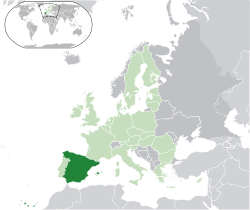Spain: Inbound Tourists Spend 49.87 Billion Euros In Year To Date Up 6.4%
In the first ten months of the year, spending by inbound tourists in Spain amounted to 49.87 billion euros, a year-on-year increase of 6.4%. Increases were also recorded in average spending per tourist, of 3.2%, and in average daily spending, of 6.8%, according to the Tourist Expenditure Survey (EGATUR), drafted by the Institute for Tourism Studies of the Ministry of Industry, Energy and Tourism.
The main destinations, in terms of overall expenditure from January to October were Catalonia (22.9%), the Balearic Islands (19.9%), the Canary Islands (17.3%) and Andalusia (14.8%), accounting for 74.9% of total spending.

The United Kingdom, with a 20.5% share of total spending, Germany, with 16.3%, France with 9.2% and the Nordic countries, with 8.4%, were the main emitting markets in terms of overall spending in the period, accounting for 54.4% of the total.
Tourist spending amounted to 4.76 billion euros in October
Inbound tourists spent a total of 4.76 billion euros in October, the same figure as a year ago. This result derives from a decrease in the number of tourists (by 3.2%) as opposed to an increase in average spending per person (3.3%). Average daily spending also rose, by 4.3%, while the average length of stay dropped slightly.
The main emitting markets performed somewhat more volatility, with increased tourist spending by British and German tourists, compared with a double digit decline in spending by French tourists.
Spending by British tourists posted a 4.3% rise, amounting to close on 41 million euros more year-on-year, despite the arrival of fewer numbers of tourists. One of their main destinations – the Balearic Islands -is where the greatest rise in spending by tourists from the UK was seen.
Germany also closed the month with increased tourist spending (up 8.6%), distributed between the Canary Islands and the Balearic Islands, with more tourists visiting the former destination. Average spending, both per person and per day, also performed positively.
The Nordic countries were the third largest emitting market in terms of spending, with a total of 433 million euros and a 5.3% decline. The Canary Islands was the worst affected destination.
France posted a major decline of 18.2%, with Catalonia being the hardest hit destination. This result was due to a lower number of inbound tourists coupled with a lower average spending per person.
Italy, due to a serious decline in inbound tourists, recorded a fall in spending of 16.5%, which was particularly felt in Catalonia, one of the main destination for Italian tourists. On the other hand, average spending per person as well as per day both recorded increases, of 13.1% and 1.4% respectively.
Worthy of mention due to their increases were the emitting markets of Ireland and Russia.
Main destination autonomous regions
Catalonia was the autonomous region to post highest spending, with an overall increase of 9% in October 2012, as well as posting increased average spending per day and per person. This result was made possible thanks to the contributions from distant markets, with the European markets being affected by the unfavourable economic climate.
The Canary Islands posted a 1.6% rise in total spending, despite receiving fewer tourists. Average spending per day and per person also rose. Increased spending by German tourists contributed positively to this result.
In turn, the Balearic Islands posted increased spending of 9.4% in October, with average spending per person and per day also up on last year’s results. The United Kingdom and Germany were the main drivers behind this growth.
Andalusia recorded similar levels of spending, despite the arrival of fewer inbound tourists, breaking the trend of four consecutive months of growth. The positive contribution from the United Kingdom and the Nordic countries was unable to offset the negative figures from other emitting markets.
The Region of Madrid recorded lower overall spending in October, with a particular decline from distant markets. Average spending per person also fell while average daily spending remained constant.
